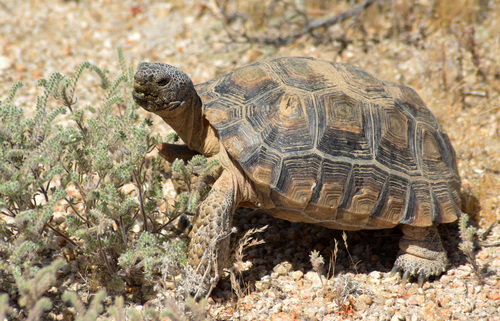
Desert Tortoise
The desert tortoise, Gopherus agassizii, thrives in harsh desert climates, skillfully burrowing to escape extreme heat. With its domed shell and powerful legs, it navigates sandy landscapes, contributing to seed dispersal and maintaining ecological balance. A true survivor of the arid wilderness.
25-60 years
Lifespan
45389.0 kg
Weight
Length: 25 - 36 cm
Size
Brown, Yellow, Black, Tan
Color
0.3 mph
Top Speed
Critically Endangered
Conservation Status
Decreasing
Population Trend
Characteristics
Gopherus agassizii, commonly known as the desert tortoise, inhabits arid regions of the southwestern United States and northwestern Mexico. It is known for its domed shell, sturdy limbs adapted for digging, and ability to survive extreme desert temperatures by creating burrows. This tortoise is primarily herbivorous and plays a crucial role in its ecosystem by facilitating seed dispersal.
Distribution Range of the Desert Tortoise
Gopherus agassizii, commonly known as the Mojave Desert Tortoise, is native to the southwestern United States, primarily distributed across the Mojave and Sonoran Deserts. This species is primarily found in southeastern California, southern Nevada, southwestern Utah, and northwestern Arizona.
Desert Tortoise's Habitat
Environmental Conditions
The Mojave Desert Tortoise inhabits desert and semi-arid environments characterized by sparse vegetation, rocky terrain, and sandy soils. The climate in these areas is typically arid with hot summers and mild winters. Rainfall is scarce, averaging less than 250 mm per year, often occurring in brief, intense storms.
Ecological Niche
Gopherus agassizii is adapted to a desert lifestyle, spending much of its time in burrows to escape extreme temperatures and conserve moisture. It plays a significant role in its ecosystem by contributing to soil aeration and nutrient cycling. The tortoise is primarily herbivorous, feeding on a diet of grasses, wildflowers, and cacti, which provide both nutrition and hydration. Its ability to survive in harsh desert conditions is facilitated by its physiological and behavioral adaptations, such as water retention and seasonal activity patterns.
Copyright @ Nature Style Limited. All Rights Reserved.
 English
English